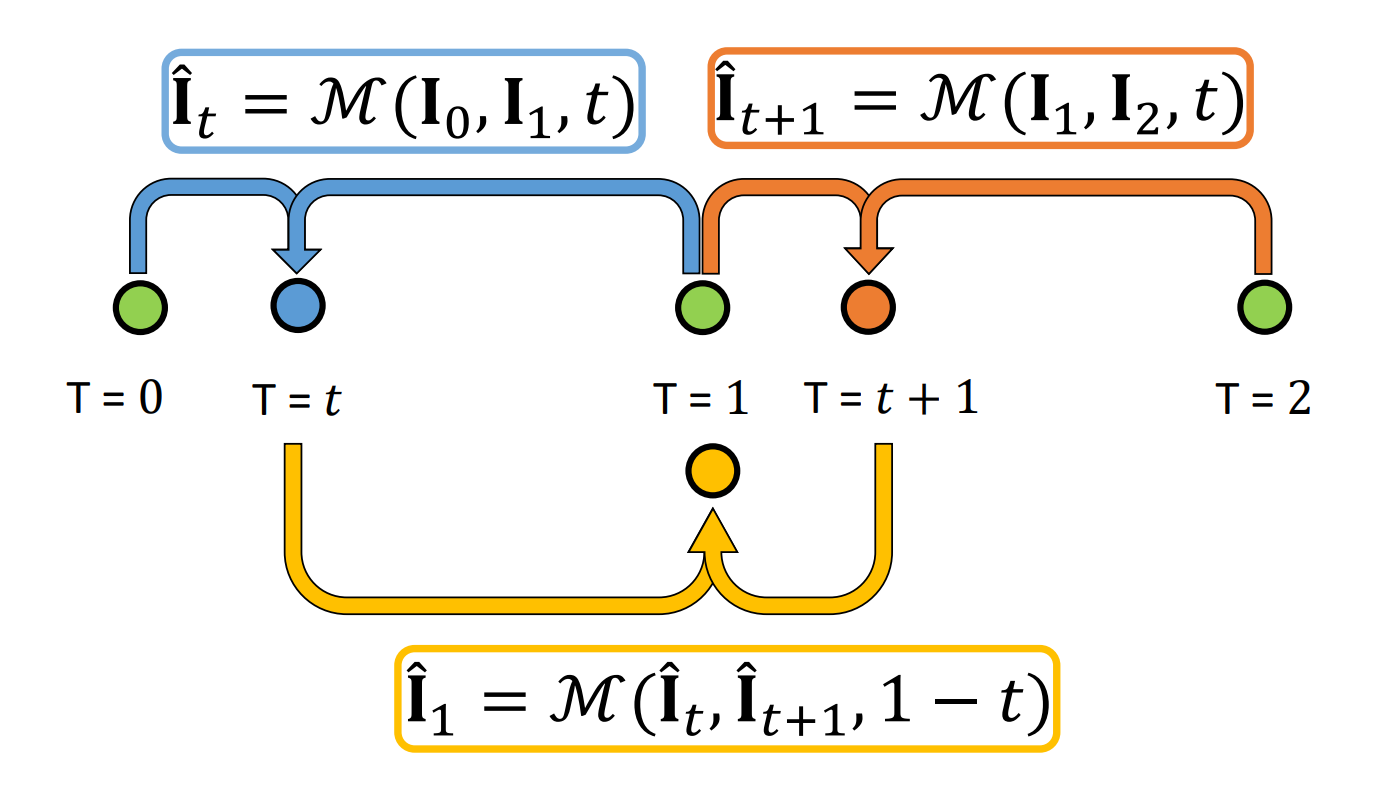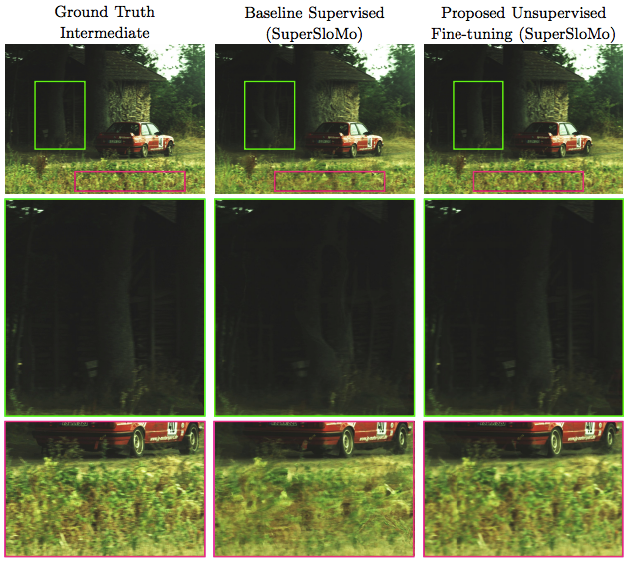unsupervised-video-interpolation
Fitsum A. Reda, Deqing Sun*, Aysegul Dundar, Mohammad Shoeybi, Guilin Liu, Kevin J. Shih, Andrew Tao, Jan Kautz, Bryan Catanzaro
NVIDIA Corporation
In International Conferene on Computer Vision (ICCV) 2019.
( * Currently affiliated with Google. )


Installation
# Get unsupervised video interpolation source codes
git clone https://github.com/NVIDIA/unsupervised-video-interpolation.git
cd unsupervised-video-interpolation
mkdir pretrained_models
# Build Docker Image
docker build -t unsupervised-video-interpolation -f Dockerfile .
If you prefer not to use docker, you can manually install the following requirements:
- An NVIDIA GPU and CUDA 9.0 or higher. Some operations only have gpu implementation.
- PyTorch (>= 1.0)
- Python 3
- numpy
- scikit-image
- imageio
- pillow
- tqdm
- tensorboardX
- natsort
- ffmpeg
- torchvision
To propose a model or change for inclusion, please submit a pull request.
Multiple GPU training and mixed precision training are supported, and the code provides examples for training and inference. For more help, type
python3 train.py --help
Network Architectures
Our repo now supports Super SloMo. Other video interpolation architectures can be integrated with our repo with minimal changes, for instance DVF or SepConv.
Pre-trained Models
We've included pre-trained models trained with cycle consistency (CC) alone, or with cycle consistency with Psuedo-supervised (CC + PS) losses.
Download checkpoints to a folder pretrained_models.
Supervised Baseline Weights
- pretrained_models/baseline_superslomo_adobe.pth(Losses with Paired Ground-Truth )
- pretrained_models/baseline_superslomo_adobe+youtube.pth(Losses with Paired Ground-Truth )
Unsupervised Finetuned Weights
- pretrained_models/unsupervised_random2slowflow.pth(CC only)
- pretrained_models/unsupervised_adobe2slowflow.pth(CC+PS)
- pretrained_models/unsupervised_adobe+youtube2slowflow.pth(CC+PS)
- pretrained_models/unsupervised_random2sintel.pth(CC only)
- pretrained_models/unsupervised_adobe2sintel.pth(CC+PS)
- pretrained_models/unsupervised_adobe+youtube2sintel.pth(CC+PS)
Fully Unsupervised Weights for UCF101 evaluation
- pretrained_models/fully_unsupervised_adobe30fps.pth(CC only)
- pretrained_models/fully_unsupervised_battlefield30fps.pth(CC only)
Data Loaders
We use VideoInterp and CycleVideoInterp (in datasets) dataloaders for all frame sequences, i.e. Adobe, YouTube, SlowFlow, Sintel, and UCF101.
We split Slowflow dataset into disjoint sets: A low FPS training (3.4K frames) and a high FPS
test (414 frames) subset.
We form the test set by selecting the first nine frames in each of the 46 clips, and train set by temporally sub-sampling
the remaining frames from 240-fps to 30-fps.
During evaluation, our models take as input the first and ninth frame in
each test clip and interpolate seven intermediate frames.
We follow a similar procedure for Sintel-1008fps, but interpolate 41 intermediate frames, i.e., conversion of frame rate
from 24- to 1008-fps.
Note, since SlowFlow and Sintel are of high resolution, we downsample all frames by a factor of 2 isotropically.
All training and evaluations presented in the paper are done on the spatially downsampled sequences.
For UCF101, we simply use the the test provided here.
Generating Interpolated Frames or Videos
--write_videoand--write_images, if enabled will create an interpolated video and interpolated frame sequences, respectively.
#Example creation of interpolated videos, where we interleave low FPS input frames with one or more interpolated intermediate frames.
python3 eval.py --model CycleHJSuperSloMo --num_interp 7 --flow_scale 2 --val_file ${/path/to/input/sequences} \
--name ${video_name} --save ${/path/to/output/folder} --post_fix ${output_image_tag} \
--resume ${/path/to/pre-trained/model} --write_video
- If input sequences for interpolation do not contain ground-truth intermediate frames, add
--val_sample_rate 0and--val_step_size 1to the example script above. - For a simple test on two input frames, set
--val_fileto the folder containing both frames, and set--val_sample_rate 0,--val_step_size 1.
Images : Results and Comparisons


Inference for Unsupervised Models
- UCF101: A total of 379 folders, each with three frames, with the middle frame being the ground-truth for a single frame interpolation.
# Evaluation of model trained with CC alone on Adobe-30fps dataset
# PSNR: 34.47, SSIM: 0.946, IE: 5.50
python3 eval.py --model CycleHJSuperSloMo --num_interp 1 --flow_scale 1 --val_file /path/to/ucf/root \
--resume ./pretrained_models/fully_unsupervised_adobe30fps.pth
# Evaluation of model trained with CC alone on Battlefield-30fps dataset
# PSNR: 34.55, SSIM: 0.947, IE: 5.38
python3 eval.py --model CycleHJSuperSloMo --num_interp 1 --flow_scale 1 --val_file /path/to/ucf/root \
--resume ./pretrained_models/fully_unsupervised_battlefield30fps.pth
- SlowFlow: A total of 46 folders, each with nine frames, with the intermediate nine frames being ground-truths for a 30->240FPS multi-frame interpolation.
# Evaluation of model trained with CC alone on SlowFlow-30fps train split
# PSNR: 32.35, SSIM: 0.886, IE: 6.78
python3 eval.py --model CycleHJSuperSloMo --num_interp 7 --flow_scale 2 --val_file /path/to/SlowFlow/val \
--resume ./pretrained_models/unsupervised_random2slowflow.pth
# Evaluation of model finetuned with CC+PS losses on SlowFlow-30fps train split.
# Model pre-trained with supervision on Adobe-240fps.
# PSNR: 33.05, SSIM: 0.890, IE: 6.62
python3 eval.py --model CycleHJSuperSloMo --num_interp 7 --flow_scale 2 --val_file /path/to/SlowFlow/val \
--resume ./pretrained_models/unsupervised_adobe2slowflow.pth
# Evaluation of model finetuned with CC+PS losses on SlowFlow-30fps train split.
# Model pre-trained with supervision on Adobe+YouTube-240fps.
# PSNR: 33.20, SSIM: 0.891, IE: 6.56
python3 eval.py --model CycleHJSuperSloMo --num_interp 7 --flow_scale 2 --val_file /path/to/SlowFlow/val \
--resume ./pretrained_models/unsupervised_adobe+youtube2slowflow.pth
- Sintel: A total of 13 folders, each with 43 frames, with the intermediate 41 frames being ground-truths for a 30->1008FPS multi-frame interpolation.
We simply use the same commands used for SlowFlow, but setting `--num_interp 41`
and the corresponding `--resume *2sintel.pth` pre-trained models should lead to the number we presented in our papers.
Inference for Supervised Baseline Models
- UCF101: A total of 379 folders, each with three frames, with the middle frame being the ground-truth for a single frame interpolation.
# Evaluation of model trained with Paird-GT on Adobe-240fps dataset
# PSNR: 34.63, SSIM: 0.946, IE: 5.48
python3 eval.py --model HJSuperSloMo --num_interp 1 --flow_scale 1 --val_file /path/to/ucf/root \
--resume ./pretrained_models/baseline_superslomo_adobe.pth
- SlowFlow: A total of 46 folders, each with nine frames, with the intermediate nine frames being ground-truths for a 30->240FPS multi-frame interpolation.
# Evaluation of model trained with paird-GT on Adobe-240fps dataset
# PSNR: 32.84, SSIM: 0.887, IE: 6.67
python3 eval.py --model HJSuperSloMo --num_interp 7 --flow_scale 2 --val_file /path/to/SlowFlow/val \
--resume ./pretrained_models/baseline_superslomo_adobe.pth
# Evaluation of model trained with paird-GT on Adobe+YouTube-240fps dataset
# PSNR: 33.13, SSIM: 0.889, IE: 6.63
python3 eval.py --model HJSuperSloMo --num_interp 7 --flow_scale 2 --val_file /path/to/SlowFlow/val \
--resume ./pretrained_models/baseline_superslomo_adobe+youtube.pth
- Sintel: We use commands similar to SlowFlow, but setting
--num_interp 41.
Training and Reproducing Our Results
# CC alone: Fully unsupervised training on SlowFlow and evaluation on SlowFlow
# SlowFlow/val target PSNR: 32.35, SSIM: 0.886, IE: 6.78
python3 -m torch.distributed.launch --nproc_per_node=16 train.py --model CycleHJSuperSloMo \
--flow_scale 2.0 --batch_size 2 --crop_size 384 384 --print_freq 1 --dataset CycleVideoInterp \
--step_size 1 --sample_rate 0 --num_interp 7 --val_num_interp 7 --skip_aug --save_freq 20 --start_epoch 0 \
--train_file /path/to/SlowFlow/train --val_file SlowFlow/val --name unsupervised_slowflow --save /path/to/output
# --nproc_per_node=16, we use a total of 16 V100 GPUs over two nodes.
# CC + PS: Unsupervised fine-tuning on SlowFlow with a baseline model pre-trained on Adobe+YouTube-240fps.
# SlowFlow/val target PSNR: 33.20, SSIM: 0.891, IE: 6.56
python3 -m torch.distributed.launch --nproc_per_node=16 train.py --model CycleHJSuperSloMo \
--flow_scale 2.0 --batch_size 2 --crop_size 384 384 --print_freq 1 --dataset CycleVideoInterp \
--step_size 1 --sample_rate 0 --num_interp 7 --val_num_interp 7 --skip_aug --save_freq 20 --start_epoch 0 \
--train_file /path/to/SlowFlow/train --val_file /path/to/SlowFlow/val --name finetune_slowflow \
--save /path/to/output --resume ./pretrained_models/baseline_superslomo_adobe+youtube.pth
# Supervised baseline training on Adobe240-fps and evaluation on SlowFlow
# SlowFlow/val target PSNR: 32.84, SSIM: 0.887, IE: 6.67
python3 -m torch.distributed.launch --nproc_per_node=16 train.py --model HJSuperSloMo \
--flow_scale 2.0 --batch_size 2 --crop_size 352 352 --print_freq 1 --dataset VideoInterp \
--num_interp 7 --val_num_interp 7 --skip_aug --save_freq 20 --start_epoch 0 --stride 32 \
--train_file /path/to/Adobe-240fps/train --val_file /path/to/SlowFlow/val --name supervised_adobe \
--save /path/to/output
Reference
If you find this implementation useful in your work, please acknowledge it appropriately and cite the paper or code accordingly:
@InProceedings{Reda_2019_ICCV,
author = {Fitsum A Reda and Deqing Sun and Aysegul Dundar and Mohammad Shoeybi and Guilin Liu and Kevin J Shih and Andrew Tao and Jan Kautz and Bryan Catanzaro},
title = {Unsupervised Video Interpolation Using Cycle Consistency},
booktitle = {The IEEE International Conference on Computer Vision (ICCV)},
month = {October},
year = {2019},
url={https://nv-adlr.github.io/publication/2019-UnsupervisedVideoInterpolation}
}
We encourage people to contribute to our code base and provide suggestions, point any issues, or solution using merge request, and we hope this repo is useful.
Acknowledgments
Parts of the code were inspired by NVIDIA/flownet2-pytorch, ClementPinard/FlowNetPytorch, and avinashpaliwal/Super-SloMo.
We would also like to thank Huaizu Jiang.
Coding style
- 4 spaces for indentation rather than tabs
- 80 character line length
- PEP8 formatting




